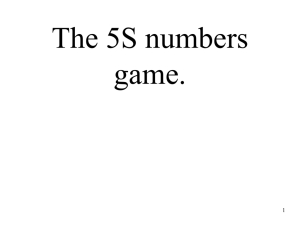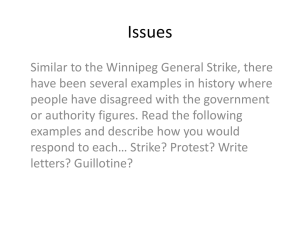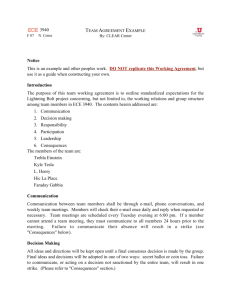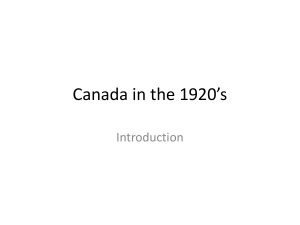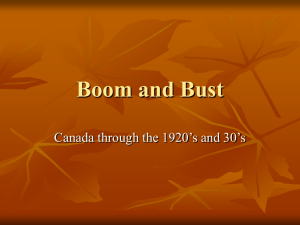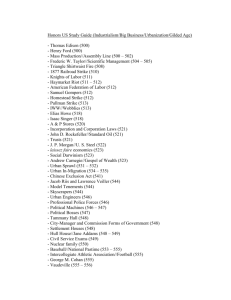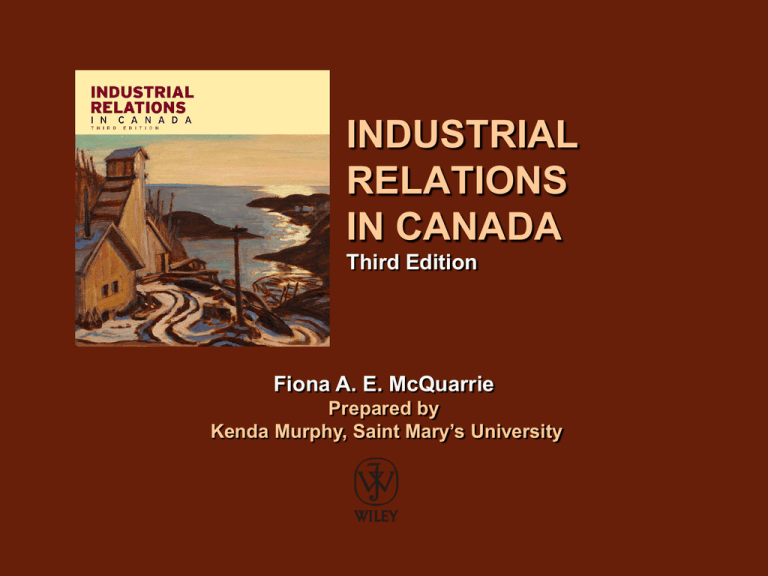
INDUSTRIAL
RELATIONS
IN CANADA
Third Edition
Fiona A. E. McQuarrie
Prepared by
Kenda Murphy, Saint Mary’s University
Chapter 9
Strikes and Lockouts
Chapter 9 Objectives
• At the end of this chapter you should be able to:
Define a strike and a lockout
Explain why a strike or lockout would be used as a
bargaining tactic
Outline the legislative guidelines for the use of a
strike or a lockout in bargaining
Describe an essential service
Outline legislative guidelines on picketing
Explain what replacement workers are and when and
how they might be used in strikes
Assess the impact of strikes in Canada
Strikes and Lockouts
• Defining Strikes and Lockouts
A strike occurs when union members in a
bargaining unit withdraw their labour
A lockout occurs when the employer closes all
or part of the workplace so that workers
cannot enter the premises to perform their
jobs
• Industrial action and industrial conflict also
describe both strikes and lockouts
Strikes and Lockouts
• A legal strike or lockout can take place only while
collective bargaining is in progress but actually
occurs because negotiations have broken down
• In most Canadian jurisdictions, the employer is
prohibited from dismissing striking employees
during a strike
• Work does not have to stop completely for a legal
strike to occur but can take the form of a work
‘slowdown’
Strikes and Lockouts
• Strikes can take the form of rotating strikes and
work-to-rule campaigns that occur when workers
apply the most narrow interpretation of the terms
of their collective agreement in order to slow
production
• Strikes happen with the purpose of inflicting
“economic pain” on the other side to force
acceptance of bargaining demands
• The party that ‘wins’ is usually the one that is
better able to withstand the economic pain
Motivations for Striking or Locking Out
• Complex motivations for strikes and lockouts:
“Strikes as mistakes”: strikes or lockouts occur as a result
of mistaken perceptions developed during bargaining;
some reasons for inaccurate perceptions:
• Lack of bargaining experience
• Limited disclosures of information
• Complexity of issues
• Miscalculations of the other side’s position
• Changes in the parties’ expectations during bargaining
“Strikes as collective voice”: strikes and lockouts are likely
to occur due to mistrust in the union-management
relationship
Factors in the Decision to Strike
• Business Structure: size of the bargaining unit
Larger units are more likely to strike than
smaller units in part because more workers are
involved in a larger bargaining unit and more
labour is withdrawn with greater impact
However, strikes involving smaller bargaining
units tend to be on strike longer than those
involving larger bargaining units
Factors in the Decision to Strike
• Individual Factors
It is the union membership that gives the
mandate to strike so it makes sense that loyal
union members will be more likely to support a
strike
Another assessment which also plays a role is
the nature and quality of the relationship
between the parties and whether strikes have
been resorted to in past negotiations
Factors in the Decision to Strike
• Economic Conditions: factors such as the
unemployment rate, financial position of the
company, general profit position in the industry, and
stage in the employer’s business cycle
• Legislative Restrictions: despite the fact that most
strikes are banned during the life of the agreement
Canada has a long history of such strike actions
occurring during the term of the collective agreement
• Bargaining Process Factors: difficult negotiations or
critical bargaining issues may be resolved through
strike or the threat of strike
How Does a Strike or Lockout Begin?
• There are several general pre-conditions to a strike
or lockout
A legal strike or lockout can occur only during
collective bargaining and when an existing collective
agreement has expired; a strike that takes place
during the term of a collective agreement is known
as a wildcat strike
A legal strike must be authorized by a secret ballot
strike vote and in most provinces, a majority vote
(usually 50% + 1) is required for a strike mandate
Most jurisdictions require third party intervention
before a strike/ lockout can take place
How Does a Strike or Lockout Begin?
• A vote in favour of a strike does not guarantee that a
strike will occur but if a union is going to strike, it must
give notice to the other party of when it will begin
• Most jurisdictions have legislation that restricts or
forbids workers in essential services from striking
• An essential service is being performed when its
withdrawal would cause a threat to public safety or
health e.g. police officers
• Governments can use ‘back to work legislation’ or
access the courts to end disputes but those actions can
often cause long term difficulty in the relationship
What Happens When a Strike or
Lockout Takes Place
• Striking workers may seek other employment in order to
supplement their strike pay
• Collective bargaining may resume during a strike or
lockout
• One party may refuse to return to the bargaining table
due to pressure of a strike or lockout
• Two major factors affect how a strike or lockout
proceeds once it begins:
Picketing
The use of replacement workers
Picketing
• Picketing serves two main functions:
It attempts to help strikers gain public support
It discourages individuals from entering the premises
• Attempting to regulate picketing can be complex
but the following offers some general guidelines:
Shared premises: if the employer shares premises
with businesses not involved with the action, the
picketers must not interfere with the enterprise of
those other businesses
Secondary picketing: picketers go to suppliers of the
business or locations that are not taking action
Picketing
• Purpose of secondary picketing is to restrict the
employer from using a secondary location to carry
out work that would usually be done at the location of
the strike or lockout
• Secondary picketing is also intended to hamper the
employer’s ability to generate revenue
• For secondary picketing of the employer’s suppliers
or other business associates to be considered legal,
the union must prove that the supplier or associate
does business only or primarily with the employer
who is the object of the strike
Picketing
• Compliance with the Law
Everyone involved in the strike or lockout must
act according to the law
Destruction of property, physical violence, or
intimidation of individuals entering or leaving
the employer’s premises is not legal
• Adherence to the Facts
Picket signs and information leaflets
distributed by picketers must contain factual
statements and must not be libelous
Picketing
• Union members may choose to cross their own
picket line or the picket line of another striking
union usually because they do not agree with the
strike
• The slang term for a person who crosses a picket
line or is a replacement worker is a scab
• Pressure may be brought to bear through the union
requesting a boycott declaration or a hot
declaration which would see other union members
having the right to not handle the goods of the
struck company
Replacement Workers
• Theoretical arguments in favour of permitting
replacement workers:
The employer’s business should not be affected
by the decision of the workers to withdraw their
labour
A prolonged shutdown or reduction in production
could cause the business lasting harm
If striking workers are not banned from earning
money from other sources of employment, it is
unfair to ban the employer from earning money
from its business operations during a strike
Replacement Workers
• Theoretical arguments against permitting
replacement workers:
Giving the employer the ability to use
replacement workers unduly favours of the
employer
The ability to replace striking workers removes
any economic incentive the employer might
have had to concede to the union’s demands
The use of replacement workers creates a
great potential for picket line violence
Replacement Workers
• B.C. and Ontario forbid the use of professional strike
breakers—individuals whose sole source of
employment is replacing striking workers
• Managers may do the work of union members at a
struck location but only if they were managers at that
location before the action began
• In some jurisdictions there will be provision for
replacement workers in essential services
• Most jurisdictions provide that the worker on strike
must be given priority over a replacement worker
when the dispute ends
Ending a Strike or Lockout
• A strike or lockout ends when:
The parties at the bargaining table reach a
collective agreement, or
One party chooses to cease its actions and,
usually, returns to bargaining
• The length of time it takes to reach either of
these points depends on several factors, the
most important being the parties’ ability to endure
the economic impact of a strike or lockout
Ending a Strike or Lockout
• Withstanding economic pain is different for each
party:
The Union: may have banked resources to
maintain strike pay over a long period and
employees may be able to secure other work
The Employer: like the union may have resources
set aside to offset the impact of a shutdown
• May also have sufficient inventory on hand, or
enough alternative sources of income, to allow it to
continue production or operations
Ending a Strike or Lockout
• Studies suggest that an employer who is allowed
to use replacement workers is more likely to
compel the union into settling a collective
agreement quickly
• If the majority of a bargaining unit accepts a
proposed collective agreement in a ratification
vote, and a new collective agreement is signed,
the strike formally ends
• The union and employer will usually agree on the
return to work conditions, including the return to
work deadline
Putting Canada’s Strike Record in
Context
• The measure of strike and lockout activity most
often used in Canadian strike records is lost
person-days—the number of days of labour lost in
a year because of industrial disputes
• Canada is held to be more strike-prone than other
industrialized nations, however, Canada has not
experienced a significant loss of work time in
recent periods-never more than 6/10th of 1%
Putting Canada’s Strike Record in
Context
• Comparing data on work stoppages in different
countries is difficult because of varying legislation,
definitions, and data collection methods
• While Canada has fewer strikes than other
industrialized nations, Canadian strikes tend to be
longer than strikes in other countries, which
accounts for a relatively high number of lost
workdays
Copyright
Copyright © 2011 John Wiley & Sons Canada, Ltd. All rights reserved.
Reproduction or translation of this work beyond that permitted by Access
Copyright (The Canadian Copyright Licensing Agency) is unlawful.
Requests for further information should be addressed to the Permissions
Department, John Wiley & Sons Canada, Ltd. The purchaser may make
back-up copies for his or her own use only and not for distribution or
resale. The author and the publisher assume no responsibility for errors,
omissions, or damages caused by the use of these files or programs or
from the use of the information contained herein.

